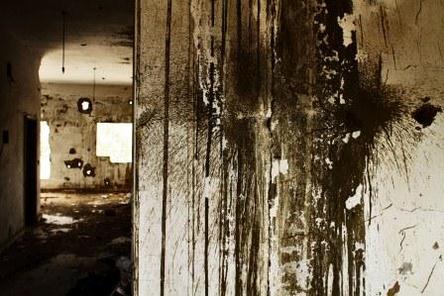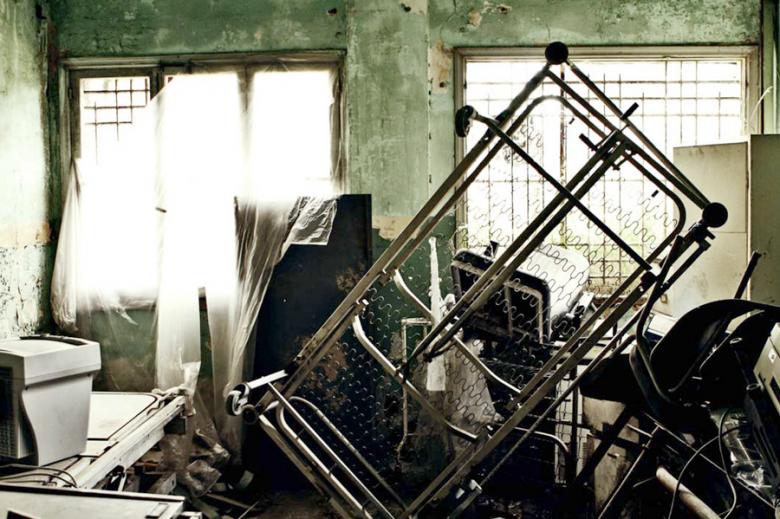Sector Zero: On the Brink of Beirut
When I slip Nadim Mishlawi’s Sector Zero (2011) DVD from its sleeve my heart is already in my throat, I am expecting to be hurt by these pictures from Lebanon, and the cruel accident of this country’s geography. But from the very opening images I am assured that beauty will be a regular accompaniment. The camera seeks out the light, it caresses the broken walls of the hospital, the touch is tender and sensitive. The word “camera” has Latin roots, and stands for a room, an in-camera session, amongst other things. In a succession of titled chapters, Talal Khoury’s camera explores a suite of rooms in a factory, a slaughterhouse, a tannery. People are secondary here, the figures have become the ground, while the walls and floors are carefully and slowly observed. Slow, the looking is so slow, as if there were time enough to gather all of the lives that lived between these walls, that touched this table, and looked out these windows. The worn surfaces shimmer with a flickering, hopeful light, as the camera draws its focal planes in and out of focus, breathing with the architecture. Not unusually, this formal, nearly studied beauty, is both cover story and unwrapping. It offers to the eye the qualities of touch.
Where are we? Mishlawi’s architectural explorations are perched at the edge of Beirut in what one commentator names “a city of outsiders,” in other words, “a reflection of Lebanon.”[1] Sandra Frem: “Beirut’s earliest experience with globalization dates back to 1888, when it was proclaimed as the capital of the Ottoman province.” [2] A growing population in the new port/capital required that its quarantine facility (“karantina” in Ottoman Turkish) be moved from the city centre to its outskirts, and a hospital was built around it. If the quarantine facility didn’t last, the name stuck, as the region’s outcasts came to find a home in these outskirts. In the 1920s there were Armenians fleeing the Turkish genocide, and in 1948 Palestinians came rushing from their former homes at gunpoint as the new nation of Israel expelled its native sons and daughters. Kurds flowed in from the rebrokered boundaries of what had been Kurdistan, traders settled in from Jordan and Iraq. Eventually the sprawl extended to encircle Beirut in what came to be known as the “misery belt,” and city officials decided to build a wall to hide its unwanted residents.
How do you make a portrait of a neighbourhood? Who might speak for all the voices that learned its alphabets on these streets? Three men, ghosts of light and shadow, appear in succession, often in voice-over. Political historian Hazem Saghiyeh details the waves of immigrant outcasts that gathered to form “Beirut’s only ghetto.” When Lebanon plunged into civil war (1975-1990), the wall fell, the area was retagged as “Christian East Beirut” and the densely populated Palestinian refugee camps were targeted, besieged and massacred by Phalange militias. In a stand alone sequence, historical footage is introduced. It is shot from the streets, and shows mostly teenagers, some of them dressed like soldiers, crouched in the rubble of what used to be home, staring through rifle sites, or else rushing out to save a wounded friend, only to be gunned down.
Beirut architect Bernard Khoury, whose office is nestled squarely in the Karantina, weighs in with personal recollections, including his design and construction of renowned nightclub B018, eight years after “the end” of the civil war. “I came back to Beirut in 1993 and obviously did not find any work…I thought I was going to be a great architectural warrior that was going to take part in the reconstruction of his country… Not only rebuilding buildings, but the reconstruction of a nation, only to realize a few years later that the reconstruction never really happened. In order for such a project to be politically feasible, you have to have some kind of political consensus, you have to go through a scarring process. This never really happened in Beirut. After 1990 we went through a long denial period which we’re still in.” [3]
Khoury names the area a scar, while at the same time insisting that the country refuses to look at its scars, hoping to quickstep its way back to its status as the Switzerland of the middle east, “a dangerous postcard that I don’t buy.” [4] What would a scarring process look like? Perhaps like Khoury’s night =club, his first Beirut project, which appears to the passerby on the street something like a helicopter landing pad, a rectangular space sunk “three or four metres below ground…This project is really about the impossibility of building a nightclub and the dangerous fascination of war destruction… so I pressed my building into the ground, its façade is the roof.” [5] His subterranean graveyard of a club was built by a garbage truck operator after traditional builders refused to take part, the seating resembles coffins. Its earliest habitués were not locals, but western journalists who could indulge in fantasies of Orientalist slaughter, realizing “the danger of fetishing war through architecture.” [6]
“That which we were frightened about, returned.” Pierre Karam (employee Tannous metal factory)
According to the director, the film was once going to be named “In the Freudian Slip,” [7] little wonder then that the third voice of Sector Zero belongs to psychoanalyst Chawki Azouri. “Historically, primitive tribes arrived at the idea of monotheism and of government simultaneously. Once government had been formed on the ground, God was formed in the sky.” [8] Does a nation have an unconscious? How many can fit on that couch? Azouri argues that the creation of group identity requires an enemy that must be found within and then cast out. What is refused is the totem, which in tribal cultures was at once cherished and sacrificed. He goes on to conjure a national Oedipal narrative, arguing that the beginnings of democracy arrive in a collective killing of the father.
“In Freud’s view we become what we cannot have, and desire (and punish) what we are compelled to disown.” Adam Phillips [9]
Azouri argues that the Karantina is at the heart of Lebanon’s national life, exactly because it is home to so much that is unwanted. The outskirts of Beirut is figured as a national, even international, dumping ground, a refuse container for all that cannot be contained within the city’s globalized crossroads. It is home to slaughterhouse, garbage dump, metal factory. Can we look to the Karantina’s bloodied streets for the necessary glue, the binding agent, that will re-imagine the national project?
“It is the individual who remembers, while groups forget because it is in their interest to forget.” [10]
[1] Dr. Chawki Azouri in Sector Zero
[2] Reclaiming The Infrastructural Landscape: The Case Of Nahr Beirut by Sandra Frem, talk delivered Oct. 2, 2009, panel topic: Transnational Tides and the Future of the Arab City, http://mit.academia.edu/SandraFrem/Talks)
[3] New Wars in Progress by Bernard Khoury, talk delivered at University of Michigan Art and Design, October 8, 2009
[4] ibid
[5] ibid
[6] ibid
[7] Nadim Mishlawi: Behind the Walls of “Sector Zero by Leah Caldwell, Al-Akhbar English, April 7, 2012.
[8] Dr. Chawki Azouri in Sector Zero
[9] Terrors and Experts by Adam Phillips, p. 76, Cambridge: Harvard University Press, 1997
[10] Dr. Chawki Azouri in Sector Zero


